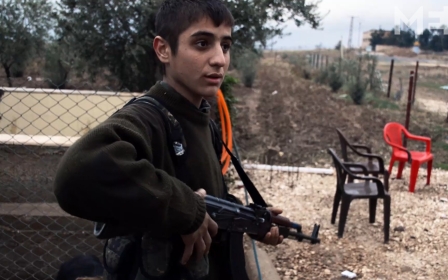Assyrians in Turkey hunger strike over recognition of 1915 genocide
Assyrian activists on Wednesday entered the third day of a four day hunger strike in southeastern Turkey, calling for the recognition of the Assyrian genocide.
The activists started their on hunger strike on Monday the in Midyat district of Mardin province demanding the recognition of the 1915 Assyrian (also known as Sayfo) genocide in its 100th year.
Representatives from Turkish trade unions and the pro-Kurdish People's Democratic Party (HDP) visited the hunger strikers on Wednesday to give their support to the cause.
Syriac Women’s Assembly member Aynur Özgün it was not "our first strike nor our last strike" stating that they had been struggling for over 25 years for the recognition of both the genocide and the Assyrian people's rights as a community.
Previously, hunger strikes have also taken place in diaspora communities around Europe.
Up to 300,000 Assyrians (a Christian people also known as Syriacs and Chaldeans according to denomination) are thought to have been killed in the genocide – which occurred concurrently with similar massacres of Armenians and Greeks – allegedly perpetrated by the revolutionary Young Turk administration which seized control in the dying days of the Ottoman Empire.
The first massacres of Assyrians were thought to have taken in southeastern Turkey (known as Diyabakir), where the hunger strike is taking place, and is alleged to have involved the killing of all male Assyrians in Mardin.
Much like the more publicised Armenian genocide, recognition of the Assyrian genocide has been highly contentious in Turkey.
The unveiling of a monument to the Assyrian genocide in Australia in 2010 was condemned by the Turkish foreign ministry, claiming it “distorted history and accused Turkey.”
The monument was later defaced and vandalised with messages reading “Fuck Armenians, Assyrians and Jews.”
On Tuesday, the Lebanese Maronite Christian Patriarch Beshara Rai called for Turkey to recognise the Assyrian genocide along with the Armenian genocide.
"The ceremony which will be held [on April 24] in Armenia serves to sanctify the martyrs," Rai told reporters in Beirut airport before traveling to a ceremony to mark the 100th anniversary of the mass killings.
"We pray for all the martyrs who were killed, whether they were Armenians, Assyrians or Syriac who were present in this large disaster."
An ancient community
Other than the United States, Syria and Iraq are home to the largest Assyrian communities, who have lived there since the establishment of the ancient Kingdom of Assyria in 2,500 BC.
But the rise of the Islamic State (IS) and their hostility to the Assyrians has led to renewed fears over the continued presence of one of the Middle East's oldest communities.
IS have been involved in massacres against Assyrians in Iraq and Syria, often demanding they choose between paying a jizya (tax demanded from non-Muslims) convert to Islam, or face death.
There have also been reports of IS destroying ancient Assyrian historical sites, such as the city of Nimrud in northern Iraq.
Some Assyrians have gone so far as to form militias like the Syriac Military Council (MFS) in northern Syria, working in tandem with the Kurdish People's Protection Unit (YPG) in defence of minorities and organising local political authorities.
Following the assault on Assyrian communities in northern Syria, the European Syriac Union (ESU) urged the international community to intervene and support the resistance to IS.
“ESU urges the European Union, the member states of the EU and the United States of America to support the political and military forces of Syriac people in Syria and other countries of the Middle East,” it said in a statement.
“Without Syriac Christian people in the Middle East a democracy and pluralism is not possible.”
Middle East Eye propose une couverture et une analyse indépendantes et incomparables du Moyen-Orient, de l’Afrique du Nord et d’autres régions du monde. Pour en savoir plus sur la reprise de ce contenu et les frais qui s’appliquent, veuillez remplir ce formulaire [en anglais]. Pour en savoir plus sur MEE, cliquez ici [en anglais].




